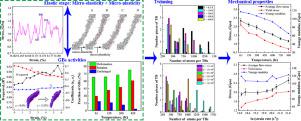当前位置:
X-MOL 学术
›
Int. J. Mech. Sci.
›
论文详情
Our official English website, www.x-mol.net, welcomes your feedback! (Note: you will need to create a separate account there.)
Influence of grain boundary activites on elastic and plastic deformation of nanocrystalline Cu as studied by phase filed and atomistic simulaiton
International Journal of Mechanical Sciences ( IF 7.3 ) Pub Date : 2020-12-01 , DOI: 10.1016/j.ijmecsci.2020.105911 Meng Zhang , Kun Sun , Liang Fang
International Journal of Mechanical Sciences ( IF 7.3 ) Pub Date : 2020-12-01 , DOI: 10.1016/j.ijmecsci.2020.105911 Meng Zhang , Kun Sun , Liang Fang

|
Abstract When the grain size is below a critical value, the deformation mechanism of nanocrystalline (NC) metal shifts from dislocation- to grain boundaries (GBs)-mediated activities. However, GB activities including deformation and rotation in the elastic and plastic stages have not given detailed analysis because of the limitation of current experimental techniques, as well as the unrealistic model with regular boundaries in most molecular dynamics (MD) simulation reducing the activities. To quantitatively analyze GB activities, we recently developed an algorithm based on moving least-squares interpolant. Besides, the phase field model was used to build the nanocrystalline (NC) Cu with more natural GBs for MD tensile simulation. The results of temperature dependence of Young's modulus (E), strain rate sensitivity (SRS), and variation of stress at GBs (σGB) and at grain interiors (σGI) are in good agreement with previous researches. In the elastic stage, the σGB fluctuates in a larger range than σGI. The vibrated σGB is the results of micro-elastic and micro-plastic deformation of GBs and the increased stage of σGB in one cycle can lead to increasing the σGI. Thus, the temperature dependence of E is affected by the frequency of vibrated σGB at relative low temperatures (T ≤ 450 K). The E is strain rate independent because of the same vibration of σGB. In the plastic stage, the flow stress strongly depends on the size of twinning boundaries (TBs) structures. The fraction of GB activities improves with increasing temperature and decreasing strain rate. GB activities can attenuate stress concentration on boundaries and then results in the formation and growth mechanism of TB changing from Shockley partial dislocation gliding on adjacent plane of stacking faults (SFs) to GB deformation. Thus, the size of TB at low temperatures and high strain rate is larger than that at the opposite conditions.
中文翻译:

相场和原子模拟研究晶界活性对纳米晶Cu弹塑性变形的影响
摘要 当晶粒尺寸低于临界值时,纳米晶 (NC) 金属的变形机制从位错介导到晶界 (GBs) 介导的活动。然而,由于当前实验技术的限制,以及大多数分子动力学(MD)模拟中具有规则边界的不切实际模型减少了活动,因此包括弹性和塑性阶段的变形和旋转在内的GB活动没有给出详细分析。为了定量分析 GB 活动,我们最近开发了一种基于移动最小二乘插值的算法。此外,相场模型用于构建具有更多天然 GB 的纳米晶 (NC) Cu,用于 MD 拉伸模拟。杨氏模量 (E)、应变率敏感性 (SRS) 的温度依赖性结果,GBs (σGB) 和晶粒内部 (σGI) 应力的变化与先前的研究非常吻合。在弹性阶段,σGB 的波动范围比σGI 大。振动的 σGB 是 GB 微弹性和微塑性变形的结果,一个周期内 σGB 的增加阶段会导致 σGI 增加。因此,E 的温度依赖性受相对低温 (T ≤ 450 K) 振动 σGB 频率的影响。由于 σGB 的振动相同,因此 E 与应变率无关。在塑性阶段,流动应力很大程度上取决于孪晶边界 (TBs) 结构的大小。GB 活动的分数随着温度的升高和应变率的降低而提高。GB活动可以减弱边界上的应力集中,从而导致TB的形成和生长机制从堆垛层错(SF)相邻平面上的肖克利部分位错滑移到GB变形。因此,低温和高应变速率下的 TB 尺寸大于相反条件下的尺寸。
更新日期:2020-12-01
中文翻译:

相场和原子模拟研究晶界活性对纳米晶Cu弹塑性变形的影响
摘要 当晶粒尺寸低于临界值时,纳米晶 (NC) 金属的变形机制从位错介导到晶界 (GBs) 介导的活动。然而,由于当前实验技术的限制,以及大多数分子动力学(MD)模拟中具有规则边界的不切实际模型减少了活动,因此包括弹性和塑性阶段的变形和旋转在内的GB活动没有给出详细分析。为了定量分析 GB 活动,我们最近开发了一种基于移动最小二乘插值的算法。此外,相场模型用于构建具有更多天然 GB 的纳米晶 (NC) Cu,用于 MD 拉伸模拟。杨氏模量 (E)、应变率敏感性 (SRS) 的温度依赖性结果,GBs (σGB) 和晶粒内部 (σGI) 应力的变化与先前的研究非常吻合。在弹性阶段,σGB 的波动范围比σGI 大。振动的 σGB 是 GB 微弹性和微塑性变形的结果,一个周期内 σGB 的增加阶段会导致 σGI 增加。因此,E 的温度依赖性受相对低温 (T ≤ 450 K) 振动 σGB 频率的影响。由于 σGB 的振动相同,因此 E 与应变率无关。在塑性阶段,流动应力很大程度上取决于孪晶边界 (TBs) 结构的大小。GB 活动的分数随着温度的升高和应变率的降低而提高。GB活动可以减弱边界上的应力集中,从而导致TB的形成和生长机制从堆垛层错(SF)相邻平面上的肖克利部分位错滑移到GB变形。因此,低温和高应变速率下的 TB 尺寸大于相反条件下的尺寸。


























 京公网安备 11010802027423号
京公网安备 11010802027423号